![]()
![]()
![]()
Use LEFT and RIGHT arrow keys to navigate between flashcards;
Use UP and DOWN arrow keys to flip the card;
H to show hint;
A reads text to speech;
103 Cards in this Set
- Front
- Back

|
Painted Plaster Figure from Ain Ghazal.
Neolithic C. 6750-6250 BCE Jordan |
|

|
Bowl from Arpachiyah with red, black, and white paint
Halaf Culture C.5000-4500 BC Iraq |
|

|
Collapsed Plan of Eanna Precinct IVa (light tan) and IVb (darker Brown)
Late Uruk Period c. 3500-3100 BCE Uruk, Modern Iraq |
|
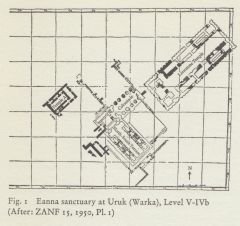
|
Limestone Temple, Mosaic Court and Pillar Hall Plan of the Eanna Precinct.
Late Uruk Period C. 3500-3100 BCE Uruk, Modern Iraq |
|
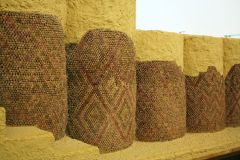
|
Mosaic Court and Pillar Hall (terracotta cones) of the Eanna Precinct.
Late Uruk Period C. 3500-3100 BCE Uruk, Modern Iraq |
|

|

Cylinder Seals (First Appearance) in Eanna Precinct on level IVb
Late Uruk Period C. 3500-3100 BCE Uruk, Modern Iraq |
|

|
Cylinder Seals (First Appearance) in Eanna Precinct on level IVb
Late Uruk Period C. 3500-3100 BCE Uruk, Modern Iraq |
|
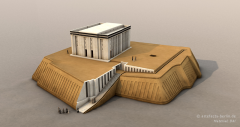
|
Anu Temple and Precinct
Jemdet Nasr Period c. 3100-2900 Uruk, Modern Iraq |
|

|
Eridu building phases
Ubaid culture c. 5,000-3,000 BC. Neolithic. Iraq. |
|

|
Warka Vase
Lade Uruk Period C.3300-3000 BCE Iraq |
|

|
Lion Hunt Stele
Lade Uruk Period C.3300-3000 BCE Iraq |
|

|
"En" Priest/King
Uruk Period C. 3500-3000 BCE Iraq |
|

|
Nude Belted Hero
Uruk Period C. 3500-3000 BCE Iraq |
|

|
Warka Head
Lade Uruk Period C.3300-3000 BCE Iraq |
|

|
Bulla with 'seal and Tokens
From Susa Bronze Age C. 5500 Iran |
|

|
Modes of Record Keeping
From Jebel Aruda C. 5500-3000 BCE Syria |
|
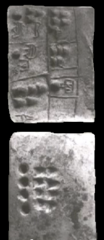
|
'Uruk IVa Tablet
Lade Uruk Period C.3300-3000 BCE Iraq |
|
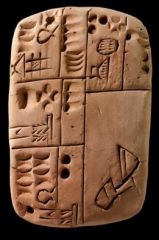
|
Uruk III Tablet
Lade Uruk Period C.3300-3000 BCE Iraq |
|

|
Letter Inside Sealed Envelope
Ur III C. 2044 BCE Possibly from Nippur |
|

|
Cylindrical Seal and its Impression.
Uruk period 4000 BC–3100 BC. Iraq. |
|

|
Cylindrical Seal and its Impression.
Jemdet Nasr period, c. 3000 BC. Iraq. |
|

|
Hematite Cylinder Seal probably from Sippar,
c. 1800 BC. Babylonian. Iraq. |
|

|
Votive statues from the Square Temple of Abu, Eshnunna (modern Tell Asmar), Iraq,
Sumerian Early Dynastic I-II, c. 2900-2550 BC . Limestone, Alabaster, Gypsum. |
|

|
Votive statue from the Square Temple of Abu, Eshnunna (modern Tell Asmar), Iraq,
Sumerian Early Dynastic I-II, c. 2900-2550 BC . Limestone, Alabaster, Gypsum. |
|

|
Nanna Ziggurat at Ur,
Sumerian Early Dynastic IIIA, c. 2650-2550 BC. Iraq. |
|

|
Plan of the “Great Death Pit” in the Royal Cemetery of Ur,
Sumerian Early Dynastic IIIA, c. 2650-2550 BC. Iraq. |
|

|
Plan of Puabi’s Tomb in the Royal Cemetery of Ur,
Sumerian Early Dynastic IIIA, c. 2650-2550 BC. Iraq. |
|

|
Plan of "Kings" Tomb in the Royal Cemetery of Ur,
Sumerian Early Dynastic IIIA, c. 2650-2550 BC. Iraq. |
|

|
Queen Puabi’s Headdress from the Royal Cemetery of Ur,
Sumerian Early Dynastic IIIA, c. 2650-2550 BC. Iraq. |
|

|
Jewelry from the Royal Cemetery of Ur,
Sumerian Early Dynastic IIIA, c. 2650-2550 BC. Iraq |
|

|
Cylindrical Seals from the Royal Cemetery of Ur,
Sumerian Early Dynastic IIIA, c. 2650-2550 BC. Iraq. |
|

|
Bull-Headed Lyre from the Royal Cemetery of Ur,
Sumerian Early Dynastic IIIA, c. 2650-2550 BC. Iraq. |
|

|
The “Ram in a Thicket” from the “Great Death Pit,” from the Royal Cemetery of Ur,
Sumerian Early Dynastic IIIA, c. 2650-2550 BC. Iraq. |
|

|
Peace Side and end of the “Royal Standard of Ur” from grave 779 in the Royal Cemetery of Ur,
Sumerian Early Dynastic IIIA, c. 2650-2550 BC. Iraq. |
|

|
War Side of the “Royal Standard of Ur” from grave 779 in the Royal Cemetery of Ur,
Sumerian Early Dynastic IIIA, c. 2650-2550 BC. Iraq. |
|

|
Peace Side of the “Royal Standard of Ur” from grave 779 in the Royal Cemetery of Ur,
Sumerian Early Dynastic IIIA, c. 2650-2550 BC. Iraq. |
|

|
Peace Side of the “Royal Standard of Ur” from grave 779 in the Royal Cemetery of Ur,
Sumerian Early Dynastic IIIA, c. 2650-2550 BC. Iraq. |
|

|
Ostrich Egg-shaped Vessels from the Royal Cemetery of Ur,
Sumerian Early Dynastic IIIA, c. 2650-2550 BC. Iraq. |
|

|
Golden Vessel from the Royal Cemetery of Ur,
Sumerian Early Dynastic IIIA, c. 2650-2550 BC. Iraq |
|

|
Game board and tokens from the Royal Cemetery of Ur,
Sumerian Early Dynastic IIIA, c. 2650-2550 BC. Iraq. |
|

|
Stele of Naram-Sin,
c. 2254–2218 BCE. Akkadian, Sippar, Iraq, |
|

|
Akkadian cylinder seals,
c. 2300-2200 BC. Akkadian, Iraq. |
|

|
Akkadian cylinder seals,
c. 2300-2200 BC. Akkadian, Iraq. |
|

|
Akkadian cylinder seals,
c. 2300-2200 BC. Akkadian, Iraq. |
|

|
Hashhamer's cylinder seal, governor of city of Ishkun-Sin, servant of Ur-Nammu, 'strong man, king of ur' cylinder seal
2112-2095 BCE Third Dynasty of Ur Iraq |
|

|
Votive statue of Gudea,
c. 2090 BCE. Lagash Style. Iraq. |
|

|
Stele of Hammurabi,
c 1792–1750 BCE. Old Babylonian. Susa, Iran. |
|

|
Lion Gate from the Hittite capital Hattusa (now Boğazköy),
c. 1400 BC. Hittite. Turkey. |
|

|
Stag-shaped silver drinking cup with a handle,
c. 1300-1200 BC. Hittite. Turkey. |
|

|
Mold-made clay figurines excavated by Loftus at Susa.
Second half of 14th cen. BC. Elamite (Middle Period). Susa, Iran. |
|

|
Bronze Statue of Queen Napirasu from Susa.
c. 1300. Elamite. Iran |
|

|
North-West Palace of King Ashurnasirpal II at Nimrud.
c. 865 BC. Assyrian. Northern Iraq. |
|

|
Upper register of Throne Room Relief,
Charioteers Pursue Enemies of King Ashurnasirpal II at Nimrud Palace. c. 865 BC. Assyrian. Northern Iraq. |
|

|
King Assurnasirpal II Killing Lions from the Throne Room of His Palace at Nimrud.
C. 865 BC. Assyrian. Iraq. |
|

|
Throne Room Relief Diagram of the North-West Palace of King Ashurnasirpal II at Nimrud.
c. 865 BC. Assyrian. Northern Iraq. |
|

|
Reliefs decorating the Throne Room in the North-West Palace of King Ashurnasirpal II at Nimrud.
c. 865 BC. Assyrian. Northern Iraq. |
|

|
Reliefs decorating Room G in the North-West Palace of King Ashurnasirpal II at Nimrud.
c. 865 BC. Assyrian. Northern Iraq. |
|

|
Glazed Brick with king holding a bowl and cup between two Attendants in the North-West Palace of King Ashurnasirpal II at Nimrud.
c. 865 BC. Assyrian. Northern Iraq. |
|

|
Lamassu in the North-West Palace of King Ashurnasirpal II at Nimrud.
c. 865 Bc. Assyrian. Northern Iraq. |
|

|
Genie or Minor Deity form the Palace of King Ashurnasirpal II at Nimrud Palace.
c. 865 BC. Assyrian. Northern Iraq. |
|

|
Ivory panel shaped like a stylized tree of Phoenician type excavated from Room X in North-West Palace at Nimrud,
8th century BC. Samarian or Assyrian?. Iraq. |
|
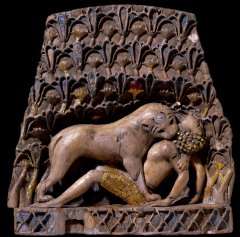
|
Ivory panel with a lion attacking a Nubian boy of Phoenician type excavated from a well in the North-West Palace at Nimrud,
8th century BC. Samarian or Assyrian?. Iraq. |
|

|
Goat eating a tree from Nimrud,
c. 8th century BC. Assyrian?. Iraq. |
|

|
Tridacna shell with incised decoration including Egyptian sphinxes, cosmetic vessel,
c. 700-650 BC. Phoenician?. Israel? (excavated from Vulci, Italy). |
|

|
Phoenician bronze bowl from the tombs of the women in the North-West Palace at Nimrud,
8th century BC. Phoenician in Assyrian Context. Israel or the Levant. |
|

|
Winged Hero contesting with a Lion for a Bull on a Carnelian Cylinder seal,
c. 1000-539 BC. Neo-Babylonian. Iraq. |
|

|
Reconstruction drawing of Babylon, with Hanging Gardens and Ishtar Gate.
6th century BCE. Neo-Babylonian. Iraq. |
|

|
Reconstructed Ishtar Gate and throne room wall,
Ishtar Gate. c. 575 BCE. Neo-Babylonian. Iraq. |
|

|
Reconstructed Processional Way from Babylon.
c. 575 BCE. Neo-Babylonian. Iraq |
|

|
Nebuchadnezzar’s Inscription from the reconstructed Ishtar Gate from Babylon.
c. 575 BCE. Neo-Babylonian. Iraq. |
|

|
Eastern entrance of the Apadana (Audience Hall) of Darius I and Xerxes I at Persepolis,
518–c. 460 BCE. Persian. Persepolis, Iran. |
|
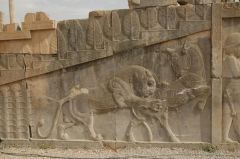
|
Eastern entrance of the Apadana (Audience Hall) of Darius I and Xerxes I at Persepolis,
518–c. 460 BCE. Persian. Persepolis, Iran. |
|

|
Scythians with pointed hats carrying gold and a scabbard with a Mede with a round had, above Ionians with cloth and wool, detail of a relief from the stairway leading to the Apadana, at Persepolis,
518–c. 460 BCE. Persian. Persepolis, Iran. |
|

|
Armenian in Iranian horseman’s dress from the Apadana (Audience Hall) of Darius I and Xerxes I at Persepolis,
518–c. 460 BCE. Persian. Persepolis, Iran. |
|

|
Darius and Xerxes Receiving Tribute, detail of a relief from the stairway leading to the Apadana, at Persepolis,
518–c. 460 BCE. Persian. Persepolis, Iran. |
|

|
Archers Glazed Brick Relief Decoration from the Royal Complex at Susa,
after 540 BCE. Persian. Iran. |
|

|
Glazed Brick Relief Decoration from the Royal Complex at Susa,
after 540 BCE. Persian. Iran. |
|

|
Bull Relief of the Ceremonial Complex,
Persepolis, 518–c. 460 BCE. Persian. Iran. |
|

|
Gold Bracelet in The Achaemenid Court style from the Oxus Treasure,
4th-5th century BC. Assyrian. Iraq. |
|

|
Beak-spouted vessel probably from a cemetery near Tepe Sialk,
c. 1000-800 BCE. Bronze Age Northern Iran. |
|

|
Beak-spouted vessel,
c. 1000-800 BCE. Bronze Age Northern Iran. CWAM. |
|

|
Ribbed ceramic bowl,
c. 1st to 2nd cen. BCE. Bronze Age. Northern Iran. CWAM. |
|

|
Burnished grayware bridge-spouted jug on tripod stand.
c. 800 BCE. Bronze Age. North-west Iran |
|

|
Horse-shaped vessel,
c. 3rd cen. BCE to CE 3rd cen. Early Parthian, Northern Iran, CWAM. |
|

|
Vessel with bull’s head,
c. 3rd cen. BCE to CE 3rd cen. Parthian, Northern Iran. |
|

|
Camel-shaped vessel,
c. 3rd cen. BCE to CE 3rd cen. Parthian. Northern Iran. |
|

|
Ibex or goat-shaped vessel,
c. 3rd cen. BCE to CE 1st cen. Early Parthian. Northern Iran. CWAM. |
|

|
Bird-shaped vessel,
c. 3rd cen. BCE to CE 3rd cen. Parthian, Northern Iran. |
|

|
Plan of the settlement of Dimini in Thessaly, looking east.
c. 3700-3300 BCE. Late Neolithic (III-IV). Greece. |
|

|
Reconstruction of the House of Tiles, Lerna III.
Early Helladic II. Greece. |
|

|
Cycladic Figure of a Woman.
2600–2400 BCE. Early Cycladic. Cyclades, Greece. |
|

|
Cycladic Male Musician Figurines,
c. 2600-2400 BC. Early Bronze Age. Cyclades, Greece. |
|

|
“Frying pan-” shaped object from Syros,
Chalandriani. Early Cycladic II Period. Syros, Greece |
|

|
Minoan “palace” at Phaistos.
c. 2000-1700 BC. First and Second Palace Period of the Middle Bronze Age (MMI). Crete |
|

|
Minoan First “Palace” at Phaistos.
c. 2000 BC. First Palace Period of the Middle Bronze Age (MMI). Crete. |
|

|
Phaistos Disk.
c. 1700s BC. First Palace Period of the Middle Bronze Age (MMIIIB). Crete. |
|

|
Kamares Ware Jug.
c. 2100-1900 BC. First Palace Period of the Middle Bronze Age (MMIA). Crete. |
|
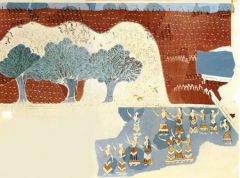
|
Detail of miniature “Sacred Grove” fresco of women dancing, in the Palace at Knossos.
c. 1500 BC. Second Palace Period of the Middle Bronze Age (Neopalatial, MMIIIA-B). Crete. |
|

|
Hypothetical reconstruction of the so-called ‘Window of Appearances’ in the west façade of the palace at Knossos.
c. 1700 BC. First Palace Period of the Middle Bronze Age (MMIII). Crete. |
|

|
Detail of miniature Palace Façade fresco of women dancing, in the Palace at Knossos.
c. 1500 BC. Second Palace Period of the Middle Bronze Age (Neopalatial, MMIIIA-B). Crete. |
|

|
Knossos
|
|

|
Figurines from the peak sanctuary of Petsophas near the east town of Palaikastro.
c. 2000-1700 BC. First Palace Period of the Middle Bronze Age (MMIII). Crete. |
|

|
Bull Capitals from the Royal Complex at Susa,
after 540 BCE. Persian. Iran. |

